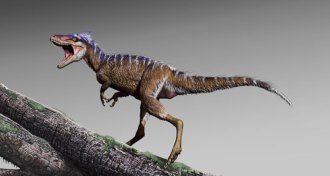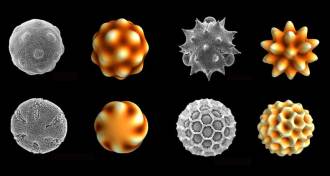Uncategorized
-
 Animals
AnimalsThe world’s largest bee has been rediscovered after 38 years
Researchers rediscovered the world’s largest bee living in the forests of an island of Indonesia.
By Jeremy Rehm -
 Climate
ClimateDueling dates for a huge eruption reignite the debate over dinosaurs’ death
New dating techniques for the Deccan Traps volcanic eruptions disagree on whether they were the main culprit in the dinosaurs’ demise.
-
 Paleontology
PaleontologyA deer-sized T. rex ancestor shows how fast tyrannosaurs became giants
A newly found dinosaur called Moros intrepidus fills a hole in the evolutionary history of tyrannosaurs, helping narrow when the group sized up.
By Jeremy Rehm -
 Chemistry
ChemistryWhy kids may be at risk from vinyl floors and fire-resistant couches
Children from homes with all vinyl floors and flame-retardant sofas show higher levels of some synthetic chemicals in their bodies than other kids.
-
 Artificial Intelligence
Artificial IntelligenceWhy a data scientist warns against always trusting AI’s scientific discoveries
Artificial intelligence that helps make scientific discoveries needs to get better at admitting its uncertainty, Genevera Allen says.
-
 Planetary Science
Planetary ScienceNeptune’s smallest moon may be a chip off another moon
Neptune’s tiniest moon probably formed when a comet hit a larger moon.
-
 Life
LifePhysics explains how pollen gets its stunning diversity of shapes
These pollen patterns can all be explained by one simple trick of physics: phase separation.
-
 Planetary Science
Planetary ScienceMars’ lake may need an underground volcano to exist
If a lake under Martian ice is real, there must be a subsurface magma pool to keep conditions warm enough for water to remain liquid, scientists say.
-
 Physics
PhysicsThe quest for quasicrystals is a physics adventure tale
In ‘The Second Kind of Impossible,’ physicist Paul Steinhardt recounts his journey to find quasicrystals in nature.
-
 Climate
ClimateTidal floods driven by climate change may hurt small businesses
Parking data from Annapolis, Md.’s historic downtown shows how tidal flooding, driven by sea rise, can hurt local business.
By Sujata Gupta -
 Neuroscience
NeuroscienceBrain cells combine place and taste to make food maps
A select group of brain cells responds to both flavor and location, a specialty that may help an animal find the next good meal.
-
 Archaeology
ArchaeologyTooth plaque shows drinking milk goes back 3,000 years in Mongolia
The hardened plaque on teeth is helping scientists trace the history of dairying in Mongolia.